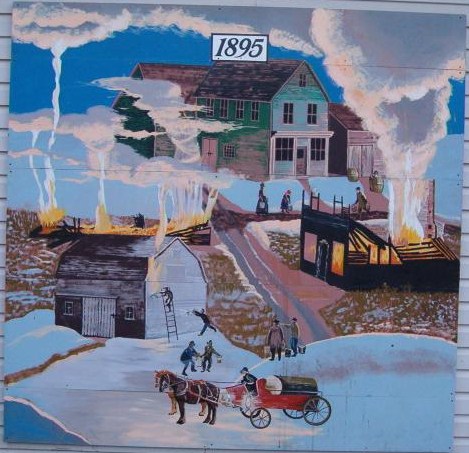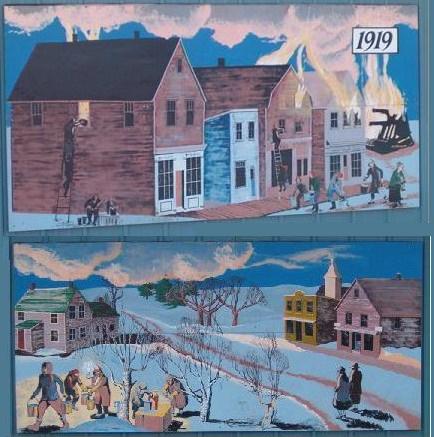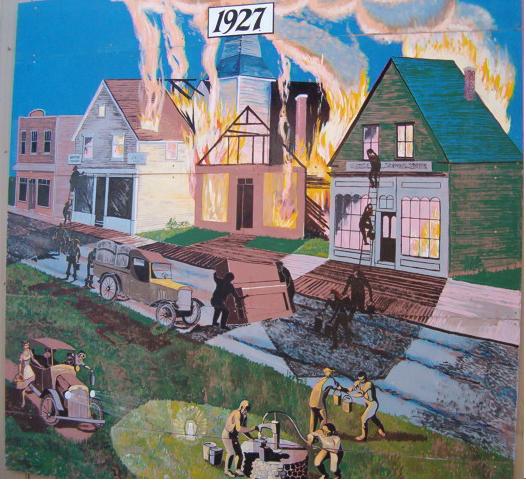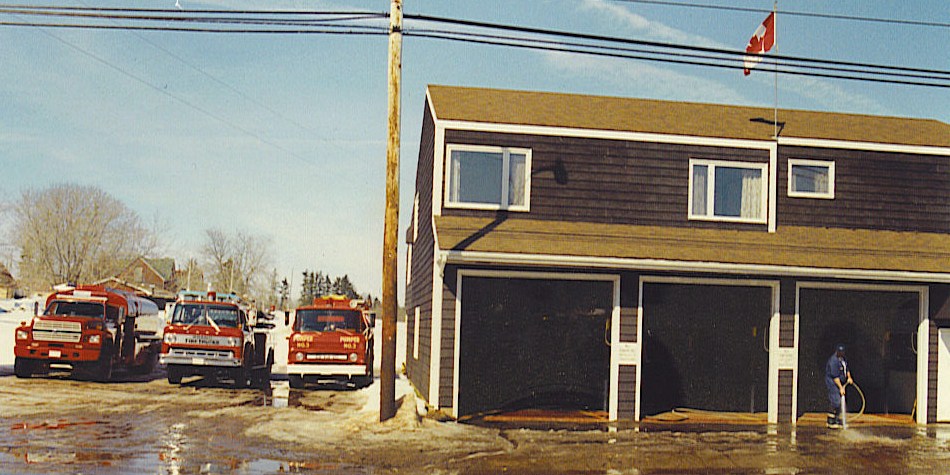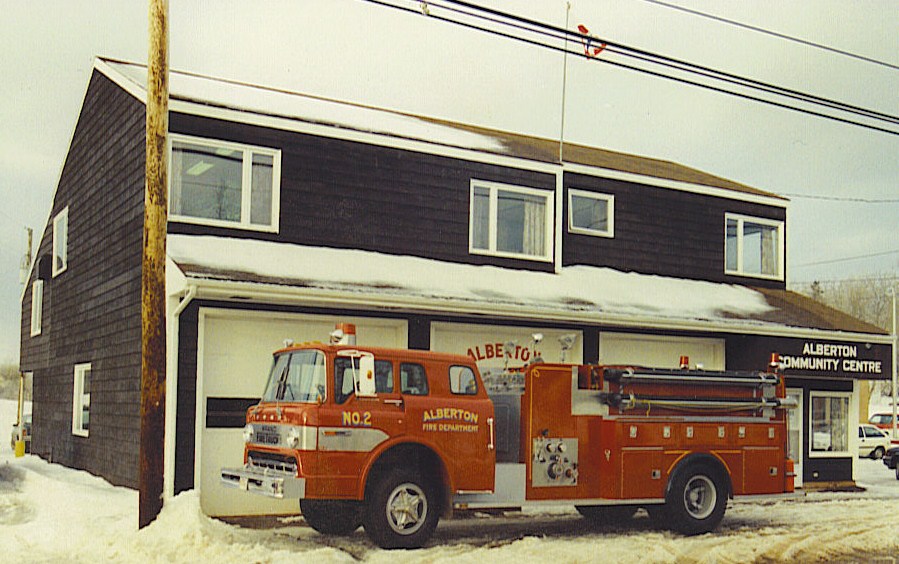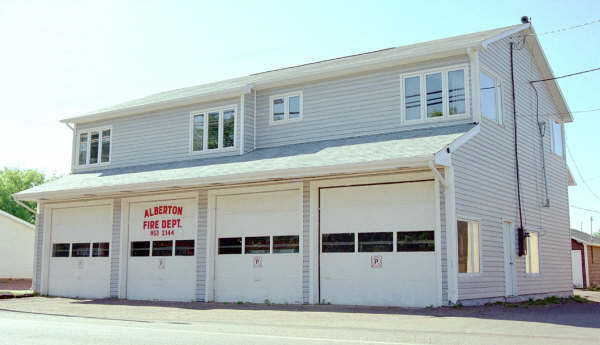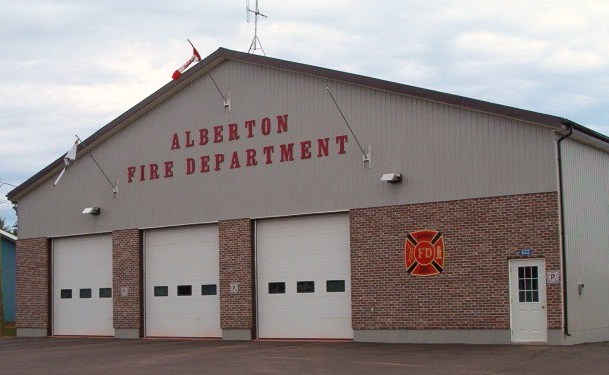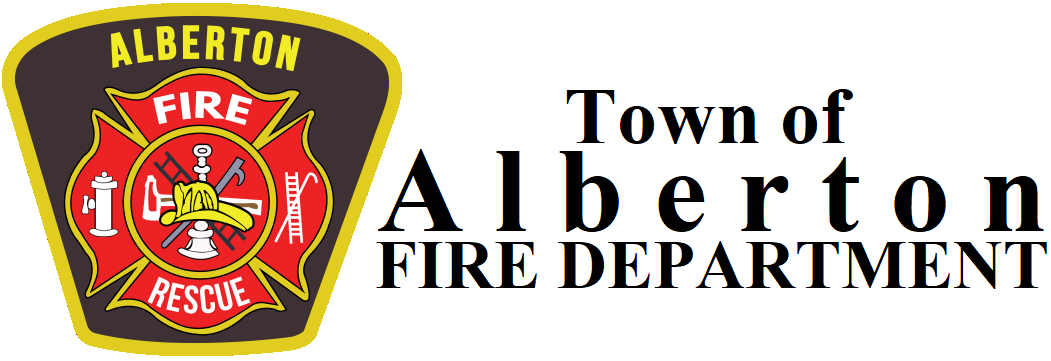
|
Home Contact About Fire Prevention News Permits Recruiting Town of Alberton |

| About Us |
Our History
The Alberton Volunteer Fire Department was formed in 1876. The fire department of that time is a stark contrast to the department of today, in regards to equipment and training. The organization known as the Alberton Fire Department was born out of a meeting of householders who appointed a committee to inquire about obtaining a fire engine for Alberton. It was soon learned that a fire engine with one hundred feet of hose could be purchased for the sum of $500. With this information, a committee was struck to recruit members and to petition the Provincial Legislature for financial aid in purchasing the above mentioned equipment. The committee consisted of Hon. R.B. Reid, John T. Weeks, Benjamin Rogers, P. Gavin, and M. Foley. Two years would pass before this equipment came into the possession of the Town during which several major buildings would be consumed by fire.  In 1878 when the Act for the better government of rising towns and villages was passed, several steps were taken to better protect the town from fire. It was declared that part of the money acquired through taxation was to be put towards fire prevention and firefighting. Also, several fire safety regulations were put in place. These regulations required that homeowners have a leather or galvanized iron bucket which could hold no less than two gallons, was clearly identified as belonging to the owner, and was stored in or near the entry of a building. Failing to comply with this order would result in a fine of $1.00 being levied against the homeowner. This is a mere pittance today but had very different implications at that time. The fire regulations also required that each building have a ladder on the premises tall enough to reach the roof of the building. Semi-annual inspections were carried out by fire wardens Benjamin Rogers, David Hunter, Peter Gavin, Benjamin Champion, and Alexander MacLeod to insure these regulations were upheld. The wardens also inspected flues and stovepipes to ensure they were in working order and to see that ashes were disposed of properly. Fire regulations also obligated inhabitants to assist the Fire Wardens in the event of a fire. Failure to meet this obligation made that individual liable to a $5.00 fine. September, 1878 was a period of great pride and excitement for firefighters and the Town as a whole when the first fire engine finally arrived in Alberton. It had cost a total sum of $600.00 and was on display at the railway station for several days after its arrival. Though this was definitely an improvement it would ultimately prove to be insufficient to meet the needs of the Town. In the decades that followed, the performance of this fire engine and the mettle of the townspeople would be tested in a series of devastating fires that would destroy large sections of the Town. In April, 1885 a fire broke out in a commercial building and would soon spread to consume at least five other commercial properties and numerous other small buildings. The fire was discovered late one Sunday evening and would rage for several hours before being brought under control. A large crowd, hampered by strong winds, fought the flames into the early morning hours of the following Monday. Just over a decade later, in December, 1895, the townspeople would again rally to fight a large fire that was started by an overheated stovepipe in a grocery store. A bucket brigade was quickly formed to cover the approximately 180 meter distance between the fire scene and a brook. Before being contained, this fire would also devour a house and two barns. In May, 1913 Alberton was incorporated as a Town. Fire prevention efforts were redoubled with three Town Councillors being named as responsible for inspecting flues and stovepipes. These inspections also included a verification of each residence to ensure a bucket and ladder for use in firefighting were on the premises. The responsibility for inspection would ultimately be handed over to the Town police constable. From the time of incorporation until 1916 there is no known record of firefighting equipment in Alberton. In September of that year, during a Town meeting, a local resident spoke of the firefighting equipment in use by the Town of Summerside. Within two months of this meeting the Town would make plans to obtain a chemical fire engine, canvas buckets, hooks, ladders, axes, and a two-wheeled ladder truck. A body of men was also formed to serve as firefighters with Herbert Clark being elected as Fire Chief. The newly acquired equipment was stored in a private warehouse and the bell of St. Peter's Anglican Church was rung to summon members to a fire. Further meetings were held in 1917 to bolster the ranks of the fire brigade and organize the acquisition of more equipment. In May of that year George Profit was appointed as Fire Chief. He would hold that position for several months until work commitments forced him to step down. Mr. Profit would continue to volunteer with the fire brigade and T.C. Bell would be appointed as Fire Chief. In March, 1919 the Town would again face the brunt of a devastating fire. In the early morning hours a fire would break out in a hall that was nestled amongst buildings of the business section of Main Street. Bucket brigades were quickly formed but in the following hours a huge swath of the Town's commercial and business buildings would be consumed. The losses included professional offices, stores, a bank, warehouses, and residences. A firebreak was made by tearing down a shed to prevent further spread of the flames. As the sun rose and the effects of the night's events became apparent, it was a surreal sight. Despite the efforts of firefighters and the citizenry all but a couple of the Town's businesses were spared.
In 1927 fires in March and August of that year would again cause havoc with consequences just as severe as those of 1919. The fire of March claimed a business, a hall, and a private home. In August, businesses and homes would go up in smoke as well as St. Peter's Anglican Church. This was the same church whose bell had summoned firefighters and townsfolk alike to fight fires for over a decade. Many had fought valiantly to stop the flames but their efforts were hampered by the inadequacy of the firefighting equipment. It was after these events that a determined effort was made to secure adequate firefighting equipment and form a well-trained fire department. The following month, a special Town Council meeting would be convened and arrangements would be made to secure a loan to procure new equipment. This equipment included a pump, hose, nozzles, and other required equipment. A building on Dufferin Street was acquired to store the equipment. During a Town meeting on 17 January, 1928 a few dozen citizens volunteered to serve in a reorganized fire department with John A. Wilson elected as Fire Chief. The volunteers were divided into companies and regular training sessions commenced. Firefighters and community organizations undertook numerous fund raising efforts and in a short period of time collected several hundred dollars. These funds were utilised for equipment and the construction of water tanks in parts of town out of reach of a water source. During 1942 a new fire hall was established on Church Street. It was out of this location that a local headquarters for Air Raid Precaution (ARP) Control was established as part of World War II defences. At the end of the war firefighting equipment which had been owned by the Civil Defence Committee was purchased for use by the Fire Department. Arrangements were also made for the acquisition of a used truck to replace a truck that had fallen into a state of disrepair. In the decades that followed replacement trucks would be acquired for the Department. More information on these trucks can be learned by visiting our Decommissioned Vehicles and Current Fleet pages. The changing needs of not only the Fire Department but the Town itself necessitated the construction of a new building. Construction of a combined Fire Hall and Town Hall began in 1963. It is believed that this structure originally had two truck bays and offices for Town administration. Town Fathers had the devastating lessons of the early twentieth century on their minds when equipment for the Fire Hall was being considered. It was shortly after construction was completed that a deep well and a large pump were installed at the fire hall. The power of this pump and the acquisition of enough length of hose to reach the commercial block of Main Street ensured that a steady supply of water would be available. The Fire Department and Town Offices would continue to operate from this location for the next four decades with numerous renovations and additions being made to the building. The facilities and equipment of the Department had certainly improved when compared with those of decades prior. The means to summon firefighters had also seen advances through the decades. The use of a loud siren mounted on a building in the centre of town would be sounded when word of a fire was received. It is known that such a siren was in use in 1964 and the Fire Department would retain this capability for several years. There are also accounts of the local telephone exchange operator calling the homes of firefighters to notify them a fire call had been received. The telephone would continue to be the primary means for notifying members of a fire for several decades. Around 1968 'fire telephones' were installed in the residences of select members. When a fire call was received these telephones would simultaneously ring. The members would wait a specified number of rings before picking up the phone to ensure everyone was on the line and would be able to hear the message at the same time. These members would then each be responsible for telephoning a list of firefighters to notify them of the call. In the event a firefighter was not home at the time a call was received their spouse or other family member would sometimes assume the responsibility of ensuring the information was forwarded. Another advancement in communication around this time was the installation of a two-way radio in the fire truck in 1970. In 1978 major renovations were made to the combined Fire Hall and Town Hall with construction being completed in the fall of that year. Upon completion three fire truck bays and the Town Clerk's office were on the ground floor of the building. The second floor had additional offices for Town Council, the Mayor, Fire Chief, and public meetings. Additional renovations in June, 1985 would add a dedicated meeting room for the firefighters measuring 16x36 feet added to the second floor of the building. 1983 would see the acquisition of additional two-way radio equipment and the limited introduction of pagers. At first, only a few pagers were acquired and dispatching was provided by the staff of Western Hospital. The hospital staff would continue to receive emergency calls and dispatch the Fire Department until November, 2004 when dispatching started to be provided by Message Centre PEI. This centre provides dispatching for the majority of PEI Fire Departments and several other emergency services. As there were only a few pagers those members still had the responsibility of calling other members of the Department when a call was received. Though this was still a hindrance to the smooth flow of information the use of pagers ensured members were notified of a fire call when they were away from home. The fire telephones would be gradually phased out and additional pagers would be acquired over time until each member was provided with one. In 1987 Alberton Fire Department would work with other area fire departments to acquire an important rescue system - the 'Jaws of Life.' Major fund raising and training efforts were undertaken by all departments and by July, 1988 they were ready to respond with this equipment. The Jaws of Life were stored at the Alberton Fire Hall as it was central to the other fire departments. When the need arose, Alberton Fire Department would transport the equipment to the scene where it would be utilised to quickly extract trapped casualties from vehicles or other mishaps. This was a major step forward as, prior to this new capability, emergency services in the area were forced to approach situations with insufficient tools for the job.
In the fall of 1990 more renovations would commence. The Town Clerk's office was moved to the rear of the building and the walls separating the truck bays from the former office were demolished making way for a fourth truck bay. A garage door would be added and construction for this expansion would be completed in December, 1990 with the assistance of the firefighters. This would allow all of the Department's vehicles to be stored under one roof. A separate entrance for firefighters would be added on the East side of the building which provided direct access to the apparatus floor. Pictured left is the Fire Hall circa 1999 with four truck bays. In May, 2000, as part of a bigger project celebrating the Town's history, large murals were painted on the bay doors of the Fire Hall. These murals depicted some of the major fires in the history of town which occurred in 1895, 1919, and 1927 and are pictured above on this page. November, 1997 would see another milestone in the Department's history when the first female firefighter joined. As time progressed the Fire Department and the Town Office had outgrown the limited floor space and there was no room for further expansion. In the nearly 40 years since the original building was constructed the newer fire trucks in the Department's fleet had increased in size compared with the earlier fleet but the truck bays were designed for the smaller trucks of earlier decades. Also, when the truck bays were built, poles had been installed between each bay to support the second floor of the building. This meant that some trucks had to be driven out of the Fire Hall before the passenger could climb in the cab as there was insufficient space to open the truck door. Overall, there was limited storage space and wall space for hanging bunker gear was at a premium. In 2001 discussions began for the construction of a new building and it was ultimately decided to build separate facilities for the Fire Hall and Town offices. Construction of the new Fire Hall began in the spring of 2002 and was completed in September, 2002. The Fire Department moved into its new quarters at this time. The new Fire Hall, pictured right, was situated on the Northern end of Main Street and provided 7000 square feet of floor space. The main apparatus floor is two stories in height and features three bays with each having ample parking for two trucks. The main floor also has offices, a communications centre, and a storage room. The building also has a partial second floor which features a large room for meetings/training and a kitchenette. The rear of the building housed a work shop for the Town Maintenance Department. When a new Town Hall and a Maintenance Department building were constructed on Emma Drive in Fall, 2011, the Maintenance Department vacated its space at the Fire Hall. This space was converted into a work shop, storage, and fitness room for the Fire Department.In recent years the Department has continued to develop its capabilities to respond to the changing needs of the area. In 2002, the Fire Department was accredited with other area departments with 'fire hydrant status.' As there are no fire hydrants in the area the Fire Department has developed a system of water shuttles using tanker trucks. Sufficient water is delivered in the shuttles to deliver a required amount of water equaling that which could be drawn from a fire hydrant. Having this status impacts the insurance rates for properties in the area. Over 2003-2004 the members also acquired training and equipment to respond to calls dealing with medical emergencies, confined space / high angle rescues, and cold water rescues. In 2005 the Department was recognized by the Life Saving Society for its efforts in drowning prevention by establishing a cold water rescue team. From humble beginnings, the Department has progressed into a modern and capable unit adapting to the changes and challenges the years bring. |
